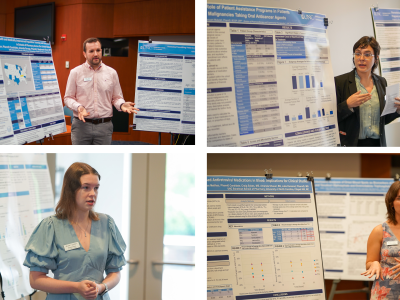March 11, 2010
A new company founded on the research of associate professor Scott Singleton, PhD, hopes to restore or boost the effectiveness of antibiotics that have been steadily losing ground to increasingly resistant bacteria.
Synereca Pharmaceuticals was created to address the growing problem of bacterial resistance to current antibiotics. The company aims to develop orally active drugs that support existing antibiotics by inhibiting the enzyme RecA, Singleton says. RecA is the focus of his work and is a key factor in bacterial DNA repair and in the development and transmission of antibiotic resistance.

“It’s astounding the diversity of roles played by RecA,” Singleton says. “It’s like an employee for a small, regional airline who does every job in the airport: taking your ticket, loading your luggage, and serving drinks. RecA is like that for bacteria.”
In March, the company signed the University’s first Carolina Express licensing agreement to commercially develop Singleton’s work, for which the University has also filed a patent. Carolina Express is designed to make starting a company based on technology invented at the UNC easier and faster by offering a standard set of terms that will cover widely divergent deals with minimal negotiation needed. The company also won a competitive Small Business Research Loan from the North Carolina Biotechnology Center, a state-funded nonprofit dedicated to developing North Carolina’s biotechnology industry.
“March was certainly a good month for Synereca,” says Singleton, who is Synereca’s president and chief scientific officer. “The company is off to a great start thanks to entrepreneurship empowered by the University and the strong support of the local RTP community. We look forward to re-arming antibiotics to help save lives.”
Singleton’s research could create a new class of antibiotics or make bacteria more susceptible to existing antibiotics, allowing patients to take much lower doses of powerful drugs whose utility is limited by their toxic side effects. These drugs are currently treatments of last resort because they can be as dangerous to patient as they are to bacteria.
“There are very few new and even fewer novel antibiotics in the pipeline,” Singleton says, noting that the FDA has approved only two new classes of antibiotic in the past forty years. “I believe that it is critical that we find ways of increasing the effectiveness of our current drug inventory.”
Re-arming Antibiotics
In the near term, Singleton says he believes RecA inhibitors will be most successful at improving the effectiveness of existing antibiotics against a wide variety of pathogenic bacteria. In his research, he has boosted the bacteria-killing power of the antibiotics ciprofloxacin, ampicillin, kanamycin, chloramphenicol, and mitomycin C by combining them with a prototype RecA inhibitor.
“Antibiotics versus bacteria is a one-on-one fight, and bacteria are getting bigger and stronger,” Singleton says. “Adding a RecA inhibitor makes it two on one. The inhibitor holds the bacterium down while the antibiotic beats it up.”
Different antibiotics target different biomolecules in a bacterium. However, recent research has shown that the most powerful antibiotics capable of killing bacteria outright share a common way of doing it: they cause the bacteria to produce hydroxyl radicals, which are extremely reactive compounds that damage all biomolecules inside the bacterial cell, especially the DNA. It is the DNA damage that leads to death of the bacterium.

A RecA Inhibitor and Cipro Take on E. coli
This graph illustrates the synergy between an antibiotic and a RecA inhibitor in killing E. coli bacteria. The black line shows how the bacterial community multiplies in a test tube, growing from 100,000 organisms to approximately 100 trillion in eight hours. Introducing the inhibitor alone (red line, open circles) has no effect on the bacteria’s growth. Introducing ciprofloxacin at half a killing dose holds the community in check. Combining the RecA inhibitor with the antibiotic at the same strength nearly wipes out the population of E. coli: only one in a million bacteria survive.
Bacteria don’t sit idly by while this damage accumulates, however. They try to counter with what is known as the SOS response. The SOS pathway allows bacteria to repair damage to their DNA. RecA is the agent that controls the SOS response and repairs the DNA damage caused by hydroxyl radicals, allowing some bacteria to survive all but the highest doses of antibiotic.
“If we can inhibit RecA, we can make the bacteria much more sensitive to an antibiotic,” Singleton says. “Perhaps more importantly, we can suppress bacteria’s ability to develop resistance to drugs.”
Overcoming the Resistance
Singleton says that while RecA inhibitors have the most near-term potential to reach commercial markets as antibiotic enhancers, he is most excited about the long-term promise of overcoming bacterial resistance. Drug resistance drives our need for new antibiotics, and we are falling behind, he says.
“The story of antibiotic development has always been years of scientific research followed by the frustratingly rapid appearance of resistant bacteria,” Singleton says. “The CDC tells us that more than 70 percent of the bacteria that cause hospital-acquired infections are resistant to at least one of the drugs most commonly used to treat them.”
In addition to allowing bacteria to survive antibiotics, RecA and the SOS response also enable bacteria to mutate themselves when under attack by medicines. This desperate gamble to survive often results in the bacteria becoming resistant to the drug that is trying to kill them.
If you take away RecA, bacteria are out of options and unable to develop new resistance to antibiotics, Singleton says. This is particularly important in hospitals, where drug-resistant bacteria often emerge, and for patients on long-term antibiotic therapy who can develop a drug-resistant strain of their own.
Scott Singleton, PhD, discusses his new company
Latest News

Dean Angela Kashuba receives Carolina Alumni Faculty Service Award

RASP poster presentations capture student research


